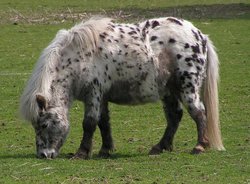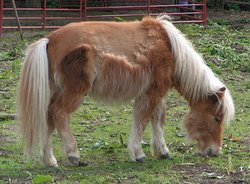Shetland pony
|
|
Shetland ponies, also known as shelts, are small (about one meter from the ground to wither) but strong for their size. Ancient equids had lived in Shetland since the Bronze Age, and later breeders crossed them with ponies imported by Norse invaders. The islanders domesticated the resulting Shetland ponies.
History of the Shetland
The Shetland Pony originated from the Shetland Islands - North East of Scotland and the Orkney Islands. The ancient ponies' roots are unknown, though it is believed that they are related to the ancient Scandinavian ponies from when the islands were joined with Scandinavia (up until 8000BC). They were probably influenced by the Celtic Pony, taken by the Celts between 1000 and 2000 AD. The harsh climate and little food developed the ponies into extremely hardy animals.
They were first used for carrying peat and ploughing. Then, in the mid-19th century, when laws were passed prohibiting children from working in coal mines, thousands of Shetlands travelled to Southern Britain to be 'pit ponies,' working underground their whole lives hauling coal. The United States mid-west coal mines also imported some of these animals.
The Shetland Stud Book Society was started in 1890 to maintain purity and encourage high-quality animals. In 1956, the Shetland Islands Premium Stallion Scheme was formed to subsidize high-quality registered stallions to improve the breeding stock.
Today, Shetlands are used as children's ponies and are also featured in the Shetland steeplechase, galloping around the course with their young jockeys.
Breed Characteristics
Despite standing less than 42 inches (the breed is not measured in hands), they are hardy and strong and can survive in rain, strong wind, snow, and very cold temperatures. They are possibly the strongest breed relative to their size, and one of the toughest ponies in the world. They are also especially long-lived.
A three year old Shetland should not exceed 40 inches and a four year old (normally fully or almost fully grown at this point) should not exceed 42 inches. Shetlands can be almost every colour, including Skewbald and Piebald, but are mainly black, chestnut, bay, brown and grey. They should not be spotted or appaloosa.
In appearance, Shetlands have a small, sometimes convex head, wide spaced eyes and small, alert ears. They have a short, muscular neck and a short, broad back with defined withers and a deep girth. The body is compact, stocky, and thickset. They have short, strong legs and a shorter than normal cannon bone in relation to their size. Their stride is springy. They have long silky manes and tails and a thick, double winter coat to withstand harsh weather.
The ponies are generally gentle and good-tempered, although they are easily spoiled and can be very headstrong if not well-trained.
Shetland ponies are found worldwide, though mainly in the UK and North America. The USA though have produced a larger, less stocky breed called the American Shetland.de:Shetlandpony nl:Shetlandpony


